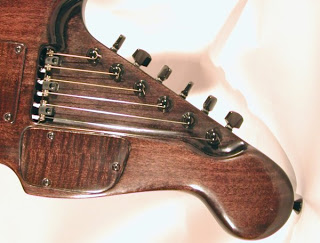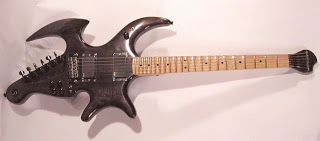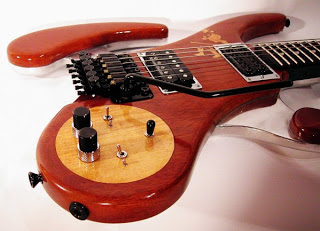Guitar
The other day, I stumbled upon an interesting and very inspiring website: KTL guitars . It is run by a Norwegian luthier, Knut Tore Ljøsne, who builds a number of very different guitars - different from one another as well as different from all the rest.
In an earlier post, I wrote about the possibility of using traditional tuners behind the bridge and having the strings go through the top of the guitar. Knut Tore actually did that on his Evil Axe guitar. He reports some tuning stability problems, but thinks that without a vibrato arm (which the Evil Axe has), it would be pretty simple to make it work properly. Since I've never been particularly fond of vibrato arms and don't intend to have one on the T-beam, that makes his approach very usable for a possible future guitar of mine (the first version will use a Schaller fine-tuning bridge).

Close up of the Evil Axe's tuners, copyright Knut Tore Ljøsne, used with permission
The Evil Axe is a remarkably beautiful instrument. Especially since everything on it - the arm rest, the horn for the strap, the two horns making up the thigh support - are there for a purpose (yes, I am a form follows function guy). It has no fancy elements "just for decoration" - perhaps except for the Strat-headstock-esque end holding the tuners, which nevertheless looks brilliant.

Evil Axe guitar, copyright Knut Tore Ljøsne, used with permission
Another of Knut Tore's guitars is the Magnum 648, Which is a lot more futuristic in its design. The body is made from a combination of wood and aluminium. Like the Evil Axe, it is a headless guitar, but it uses a Floyd Rose bridge instead of the Evil Axe's traditional tuners. Knut Tore has used an ordinary hand held router and woodworking routing bits for the aluminium part - just as I intented to do on the T-beam - and has kindly provided a couple of tips and tricks, which I look forward to employing when I start metalworking myself.

Magnum 648 , copyright Knut Tore Ljøsne, used with permission
Knut Tore's approach to guitar building involves a lot of computer modelling before the actual build. This allows for the wide variety in his guitars, since there is a greater probability that a guitar with a new design will actually sound good. Without modelling - or a very good ability to predict the acoustic characteristics of a new design - most luthiers are confined to more or less using the same proven formula for every guitar they build.
There are other very visionary and beautiful (and beautifully sounding) guitars on Knut Tore's website. I've just mentioned the two, which have most things in common with my own project. Go have a look.
- Rehousing A Danelectro Pedal
Pedal time! After the Mystery guitar (still no better name - I like die Planck, a mock German name suggested by Guitarz co-poster David from Barcelona, but I'm not sure), let's go back to my DIY fuzzbox project - and while I'm...
- Coarse Tuners Part 2
As described in an earlier post, I've tried to make a compact set of coarse tuners to go with the fine tuners on my Schaller 456 fine tuning bridge, so I could reduce the headstock and loose the big and heavy traditional tuners. The earlier attempt...
- New Tuners
I've always wanted to try out my a particular form of tuners for headless guitars and basses. They work by having a scew pulling a brass block in which the ball end of the string is mounted. The main inspiration was Jeff Turpin's tuners; drawings...
- Alternatives To The T-beam
I've tried quite a lot of places to get the crucial component, the T-beam. It is more difficult than I originally expected. I've tried a couple of scrap metal dealers and the leading Danish metal distributor. Plus a couple of web-based stores....
- Background - Why And How
Over the last years, I've become more and more interested in building guitars rather than (just) playing them. I never got around to actually building anything, but I took a couple of guitars apart and put them together again. I also discovered, that...
Guitar
Visionary lutherie
The other day, I stumbled upon an interesting and very inspiring website: KTL guitars . It is run by a Norwegian luthier, Knut Tore Ljøsne, who builds a number of very different guitars - different from one another as well as different from all the rest.
In an earlier post, I wrote about the possibility of using traditional tuners behind the bridge and having the strings go through the top of the guitar. Knut Tore actually did that on his Evil Axe guitar. He reports some tuning stability problems, but thinks that without a vibrato arm (which the Evil Axe has), it would be pretty simple to make it work properly. Since I've never been particularly fond of vibrato arms and don't intend to have one on the T-beam, that makes his approach very usable for a possible future guitar of mine (the first version will use a Schaller fine-tuning bridge).

Close up of the Evil Axe's tuners, copyright Knut Tore Ljøsne, used with permission
The Evil Axe is a remarkably beautiful instrument. Especially since everything on it - the arm rest, the horn for the strap, the two horns making up the thigh support - are there for a purpose (yes, I am a form follows function guy). It has no fancy elements "just for decoration" - perhaps except for the Strat-headstock-esque end holding the tuners, which nevertheless looks brilliant.

Evil Axe guitar, copyright Knut Tore Ljøsne, used with permission
Another of Knut Tore's guitars is the Magnum 648, Which is a lot more futuristic in its design. The body is made from a combination of wood and aluminium. Like the Evil Axe, it is a headless guitar, but it uses a Floyd Rose bridge instead of the Evil Axe's traditional tuners. Knut Tore has used an ordinary hand held router and woodworking routing bits for the aluminium part - just as I intented to do on the T-beam - and has kindly provided a couple of tips and tricks, which I look forward to employing when I start metalworking myself.

Magnum 648 , copyright Knut Tore Ljøsne, used with permission
Knut Tore's approach to guitar building involves a lot of computer modelling before the actual build. This allows for the wide variety in his guitars, since there is a greater probability that a guitar with a new design will actually sound good. Without modelling - or a very good ability to predict the acoustic characteristics of a new design - most luthiers are confined to more or less using the same proven formula for every guitar they build.
There are other very visionary and beautiful (and beautifully sounding) guitars on Knut Tore's website. I've just mentioned the two, which have most things in common with my own project. Go have a look.
- Rehousing A Danelectro Pedal
Pedal time! After the Mystery guitar (still no better name - I like die Planck, a mock German name suggested by Guitarz co-poster David from Barcelona, but I'm not sure), let's go back to my DIY fuzzbox project - and while I'm...
- Coarse Tuners Part 2
As described in an earlier post, I've tried to make a compact set of coarse tuners to go with the fine tuners on my Schaller 456 fine tuning bridge, so I could reduce the headstock and loose the big and heavy traditional tuners. The earlier attempt...
- New Tuners
I've always wanted to try out my a particular form of tuners for headless guitars and basses. They work by having a scew pulling a brass block in which the ball end of the string is mounted. The main inspiration was Jeff Turpin's tuners; drawings...
- Alternatives To The T-beam
I've tried quite a lot of places to get the crucial component, the T-beam. It is more difficult than I originally expected. I've tried a couple of scrap metal dealers and the leading Danish metal distributor. Plus a couple of web-based stores....
- Background - Why And How
Over the last years, I've become more and more interested in building guitars rather than (just) playing them. I never got around to actually building anything, but I took a couple of guitars apart and put them together again. I also discovered, that...
